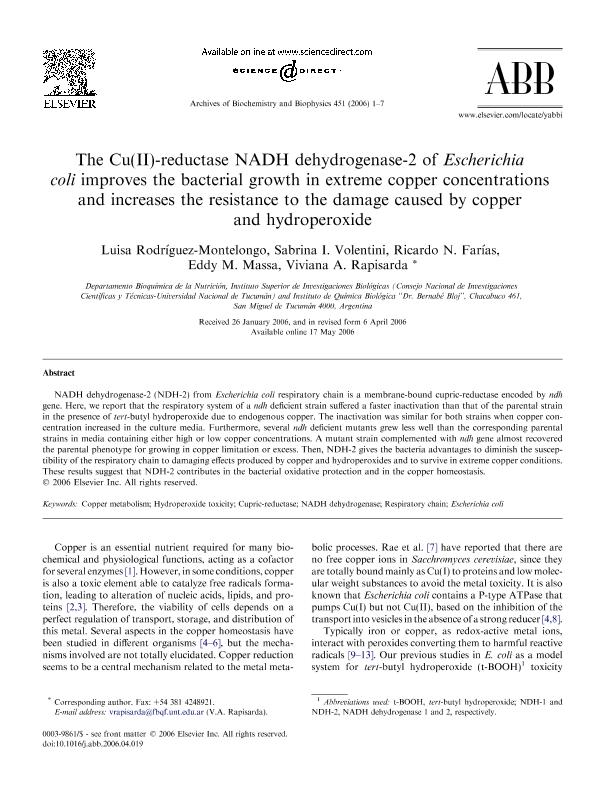Artículo
The Cu(II)-reductase NADH dehydrogenase-2 of Escherichia coli improves the bacterial growth in extreme copper concentrations and increases the resistance to the damage caused by copper and hydroperoxide
Rodríguez Montelongo, Luisa; Volentini, Sabrina Inès ; Farias, Ricardo Norberto
; Farias, Ricardo Norberto ; Massa, Eddy Marta
; Massa, Eddy Marta ; Rapisarda, Viviana Andrea
; Rapisarda, Viviana Andrea
 ; Farias, Ricardo Norberto
; Farias, Ricardo Norberto ; Massa, Eddy Marta
; Massa, Eddy Marta ; Rapisarda, Viviana Andrea
; Rapisarda, Viviana Andrea
Fecha de publicación:
07/2006
Editorial:
Elsevier Science Inc
Revista:
Archives of Biochemistry and Biophysics
ISSN:
0003-9861
Idioma:
Inglés
Tipo de recurso:
Artículo publicado
Clasificación temática:
Resumen
NADH dehydrogenase-2 (NDH-2) from Escherichia coli respiratory chain is a membrane-bound cupric-reductase encoded by ndh gene. Here, we report that the respiratory system of a ndh deficient strain suffered a faster inactivation than that of the parental strain in the presence of tert-butyl hydroperoxide due to endogenous copper. The inactivation was similar for both strains when copper concentration increased in the culture media. Furthermore, several ndh deficient mutants grew less well than the corresponding parental strains in media containing either high or low copper concentrations. A mutant strain complemented with ndh gene almost recovered the parental phenotype for growing in copper limitation or excess. Then, NDH-2 gives the bacteria advantages to diminish the susceptibility of the respiratory chain to damaging effects produced by copper and hydroperoxides and to survive in extreme copper conditions. These results suggest that NDH-2 contributes in the bacterial oxidative protection and in the copper homeostasis.
Archivos asociados
Licencia
Identificadores
Colecciones
Articulos(INSIBIO)
Articulos de INST.SUP.DE INVEST.BIOLOGICAS
Articulos de INST.SUP.DE INVEST.BIOLOGICAS
Articulos(SEDE CENTRAL)
Articulos de SEDE CENTRAL
Articulos de SEDE CENTRAL
Citación
Rodríguez Montelongo, Luisa; Volentini, Sabrina Inès; Farias, Ricardo Norberto; Massa, Eddy Marta; Rapisarda, Viviana Andrea; The Cu(II)-reductase NADH dehydrogenase-2 of Escherichia coli improves the bacterial growth in extreme copper concentrations and increases the resistance to the damage caused by copper and hydroperoxide; Elsevier Science Inc; Archives of Biochemistry and Biophysics; 451; 1; 7-2006; 1-7
Compartir
Altmétricas



